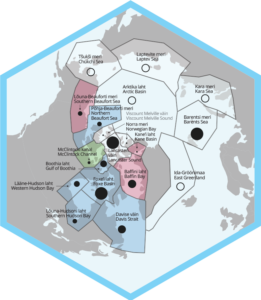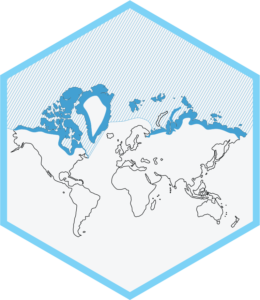Habitat
POLAR BEAR DISTRIBUTION AND HABITAT

Polar bears inhabit Arctic sea ice, islands and continental coastlines belonging to five countries: Canada, Russia, Norway, Denmark (the island of Greenland), and the USA. The estimated number of polar bears in the Arctic is 22,000–31,000, of which 60–80% live in the northern region of Canada.
Polar bear observations and research have given important information about the species. The total population of polar bears in the Arctic is divided into 19 subpopulations. With the help of radio collars it has been possible to track the migratory paths of different individuals, which often exceed their home ranges. Polar bears usually travel alone, with the exception of mothers and cubs. In search of food, mates or better conditions they can travel hundreds or even thousands of kilometres a year. Observations reveal what changes and adaptations in polar bears’ lifestyle are brought about by global warming, sea ice decline, changing diet.
Polar bears are not territorial and do not defend their home ranges against conspecifics. Depending on the varying habitat quality and constantly changing availability of prey animals, they travel throughout the year within loose, individual home ranges without marking them. Exhibiting only seasonal site fidelity, polar bears make extensive pendulum migrations. The area covered throughout the year can be considered their home range. The average home range of a polar bear is
100,000–200,000 km2. Just for comparsion: the area of Estonia is over 45,000 km².
A polar bear can cover 6,000 km of distance each year. Some individuals may travel distances of up to 6000 km per year. The polar bears which prefer seasonally changing sea ice extents have larger home ranges than those frequenting coastal areas.

The polar bear’s scientific name Ursus maritimus means sea bear. Indigenous people coexisting with polar bears have given them different names with the following meanings: white sea deer, seals’ dread, rider of icebergs, whales’ bane, sailor of the floe. The Sami people have called the polar bear God’s dog or old man in the fur cloak. In fear of offending the polar bear, they never called it by its proper name.
The Inuit name for the polar bear is Nanook. Siberian tribes used the names Gyp or Orqoi, meaning grandmother and stepfather. So they expressed their respect and reverence. The 19th century whalers called the polar bear farmer because of its slow and lumbering gait. In Russian, the name of the polar bear means white bear.
The social structure of polar bears still needs investigation. Adult polar bears are very cautious about their surroundings and tend to be solitary. Usually evading each other, they can be very aggressive when meeting. Yet they have also been seen to be friendly playing together. Polar bears communicate through body language, vocalizations and scent markings.